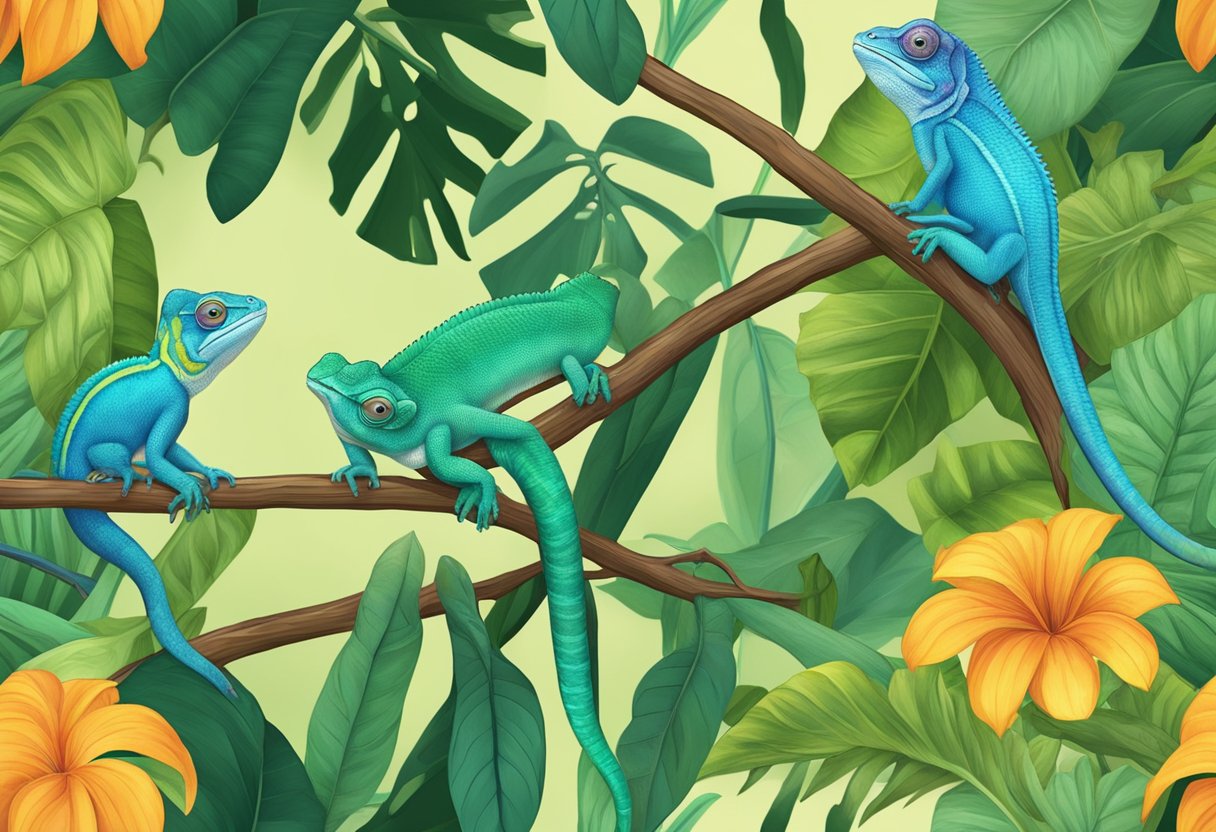Types Of Chameleons
Chameleons are fascinating creatures that have long captured the attention of animal lovers and reptile enthusiasts alike. With their unique ability to change color and blend into their surroundings, chameleons are among the most intriguing animals in the world.
There are over 150 species of chameleons, each with its own unique characteristics and traits. From the Veiled Chameleon to the Flap-Necked Chameleon, there are a variety of types of chameleons that make great pets for those who are interested in caring for these amazing creatures.
Whether you are interested in learning more about the diversity of chameleon species, their physical characteristics, natural habitats, or how to care for them in captivity, there is a wealth of information available on these fascinating animals. In this article, we will explore some of the most interesting and important facts about chameleons and their unique features.
Key Takeaways
- Chameleons are fascinating creatures with unique abilities to change color and blend into their surroundings.
- There are over 150 species of chameleons, each with its own unique characteristics and traits.
- Learning about the diversity of chameleon species, their physical characteristics, natural habitats, and how to care for them in captivity can help you better appreciate these amazing animals.
Diversity of Species

Chameleons are a diverse group of reptiles that belong to the family Chamaeleonidae. There are over 150 recognized species of chameleons, with new species still being discovered. These species are further divided into several genera, including Furcifer and Calumma.
Panther Chameleon
The Panther Chameleon (Furcifer pardalis) is one of the most popular chameleon species kept as pets. Native to Madagascar, these chameleons are known for their vibrant coloration and ability to change colors. They are also ually dimorphic, meaning males and females have different color patterns. Panther chameleons can grow up to 20 inches in length and have a lifespan of 5-7 years in captivity.
Veiled Chameleon
The Veiled Chameleon (Chamaeleo calyptratus) is another popular chameleon species, native to the Arabian Peninsula and Yemen. These chameleons are known for their impressive crests and ability to change colors. They can grow up to 2 feet in length and have a lifespan of 5-7 years in captivity.
Jackson’s Chameleon
The Jackson’s Chameleon (Trioceros jacksonii) is native to East Africa and is known for its three horns on its head. They are also ually dimorphic, with males having longer horns than females. Jackson’s chameleons are relatively small, growing up to 10 inches in length. They are also known for their ability to change colors and have a lifespan of 5-10 years in captivity.
Pygmy Chameleons
Pygmy Chameleons (Brookesia spp.) are a group of miniature chameleons native to Madagascar. They are the smallest chameleons in the world, with some species only growing up to 1 inch in length. These chameleons are not commonly kept as pets due to their small size and delicate nature.
In conclusion, chameleons are a diverse group of reptiles with over 150 recognized species. The Panther Chameleon, Veiled Chameleon, Jackson’s Chameleon, and Pygmy Chameleons are just a few examples of the different types of chameleons that exist. Each species has unique characteristics and adaptations that make them fascinating creatures to observe.
Physical Characteristics
Chameleons are known for their unique physical characteristics that make them stand out in the animal kingdom. They are small to medium-sized lizards that range from 0.85 inches to 2.2 feet long, depending on the species. They have a distinctive appearance, with long, slender bodies, crests or horns on the backs of their skulls, and uniquely-shaped feet.
Eyes and Vision
One of the most fascinating features of chameleons is their eyes. They have large, bulging eyes that are capable of moving independently of each other. This allows them to have a 360-degree view of their surroundings without having to move their head. Their vision is also exceptional, with the ability to see in both visible and ultraviolet light.
Color Changing Abilities
Another unique characteristic of chameleons is their ability to change color. They are able to change the color of their skin to blend in with their surroundings, attract a mate, or display aggression. This is achieved through the movement of special pigment cells called chromatophores in their skin.
Unique Anatomical Features
Chameleons also have a number of other unique anatomical features. They have long, sticky tongues that can be up to twice the length of their body, which they use to catch insects. Many chameleon species also have a prehensile tail, which can be wrapped around branches to aid them in climbing. Their zygodactylous feet, which have two toes pointing forward and two pointing backward, allow them to grip onto branches with ease.
In terms of colors, chameleons can change into a range of beautiful colors, including green, gray, yellow, red, purple, blue, and more. This color-changing ability not only helps them blend in with their surroundings but also serves as a form of communication with other chameleons.
Overall, chameleons are fascinating creatures with unique physical characteristics that make them stand out in the animal kingdom. Their ability to change color, exceptional vision, and specialized anatomy make them some of the most interesting lizards in the world.
Natural Habitats and Distribution
Chameleons are found in different parts of the world, with different species adapted to different environments. They are known for their ability to change color, which is a form of communication and a way to blend into their surroundings. In this section, we will explore the natural habitats and distribution of chameleons.
African Rainforests
Many species of chameleons are found in the African rainforests, which are characterized by high rainfall and dense vegetation. These chameleons are adapted to living in trees, and have long, prehensile tails that help them grip branches. They are also able to change color to blend into their surroundings, which helps them avoid predators and catch prey.
Madagascar’s Diverse Regions
Madagascar is home to a diverse range of chameleon species, which are found in different regions of the island. Some species are adapted to living in the dry forests of the west, while others are found in the rainforests of the east. Madagascar’s chameleons are known for their bright colors and unique patterns, which help them blend into their surroundings.
Asian and Middle Eastern Locations
Chameleons are also found in other parts of the world, including Asia and the Middle East. In these regions, chameleons are adapted to living in desert and tropical environments. Some species are found in the Arabian Peninsula, where they are able to survive in harsh desert conditions. Other species are found in tropical forests, where they use their long, sticky tongues to catch insects.
Overall, chameleons are adapted to living in a wide range of environments, from rainforests to deserts. They are able to change color to blend into their surroundings, which helps them avoid predators and catch prey. By understanding the natural habitats and distribution of chameleons, we can better appreciate these fascinating creatures and their unique adaptations.
Chameleon Care and Captivity
Chameleons are unique and fascinating creatures that require specific care and attention to thrive in captivity. Proper care is essential to ensure that chameleons remain healthy and happy. In this section, we will discuss the key aspects of chameleon care and captivity.
Housing and Enclosures
One of the most important aspects of chameleon care is providing them with a suitable enclosure. Chameleons require a spacious and well-ventilated enclosure that provides adequate space for them to climb and move around. The enclosure should be made of materials that are easy to clean and maintain.
Chameleons are arboreal creatures, which means they spend most of their time in trees. Therefore, the enclosure should have plenty of branches and foliage to climb and hide in. The enclosure should also have a source of heat and UVB lighting to simulate the natural environment of the chameleon.
Humidity is also an essential factor in chameleon care. Chameleons require a humid environment to prevent dehydration and promote healthy skin shedding. The enclosure should have a humidity level of around 50-70%.
Diet and Feeding
Chameleons are insectivores, which means they primarily eat insects and other small prey. In captivity, chameleons should be fed a diet of gut-loaded insects, which are insects that have been fed a nutritious diet. Crickets, mealworms, and waxworms are all suitable prey for chameleons.
It is essential to provide chameleons with a varied diet to ensure that they receive all the necessary nutrients. Feeder insects should be dusted with calcium and vitamin supplements to prevent nutritional deficiencies.
Health and Lifespan
Chameleons are generally healthy creatures, but they are susceptible to certain health issues in captivity. One of the most common health issues in chameleons is metabolic bone disease, which is caused by a lack of calcium and vitamin D3.
Regular veterinary check-ups are essential to ensure that chameleons remain healthy and free from disease. Chameleons have a lifespan of 3-10 years in captivity, depending on the species and the quality of care they receive.
In conclusion, chameleon care and captivity require specific attention to ensure that these unique creatures remain healthy and happy. Providing a suitable enclosure, a varied diet, and regular veterinary check-ups are essential to ensure that chameleons thrive in captivity.
Conservation and Threats
Chameleons are unique and fascinating creatures that have captured the attention of many. However, like many other animals, they face several threats to their survival, and conservation efforts are necessary to ensure their continued existence.
Habitat Loss and Environmental Changes
Habitat loss and environmental changes are some of the most significant threats to chameleons. Many chameleon species are endemic to specific regions, and as their habitats are destroyed, their populations decline. This is especially true for Madagascar, where several chameleon species are endangered due to deforestation and habitat fragmentation. Climate change also poses a threat to chameleons, as it alters their habitats and affects their food sources.
Impact of the Pet Trade
Chameleons are often sought after as pets due to their unique appearance and behavior. However, the pet trade has a significant impact on chameleon populations, as many are captured from the wild and sold in the market. This not only depletes their numbers but also disrupts their natural breeding patterns. Additionally, many chameleons do not survive the journey from their natural habitat to their final destination, further reducing their populations.
Conservation efforts for chameleons include protecting their habitats, regulating the pet trade, and promoting captive breeding programs. These programs aim to reduce the demand for wild-caught chameleons and provide a sustainable source of captive-bred chameleons for the pet trade. However, captive breeding programs can also pose a risk to chameleons, as they may become too dependent on humans and lose their natural instincts.
Overall, it is essential to balance conservation efforts with the needs of local communities and the pet trade industry to ensure the long-term survival of chameleons.






